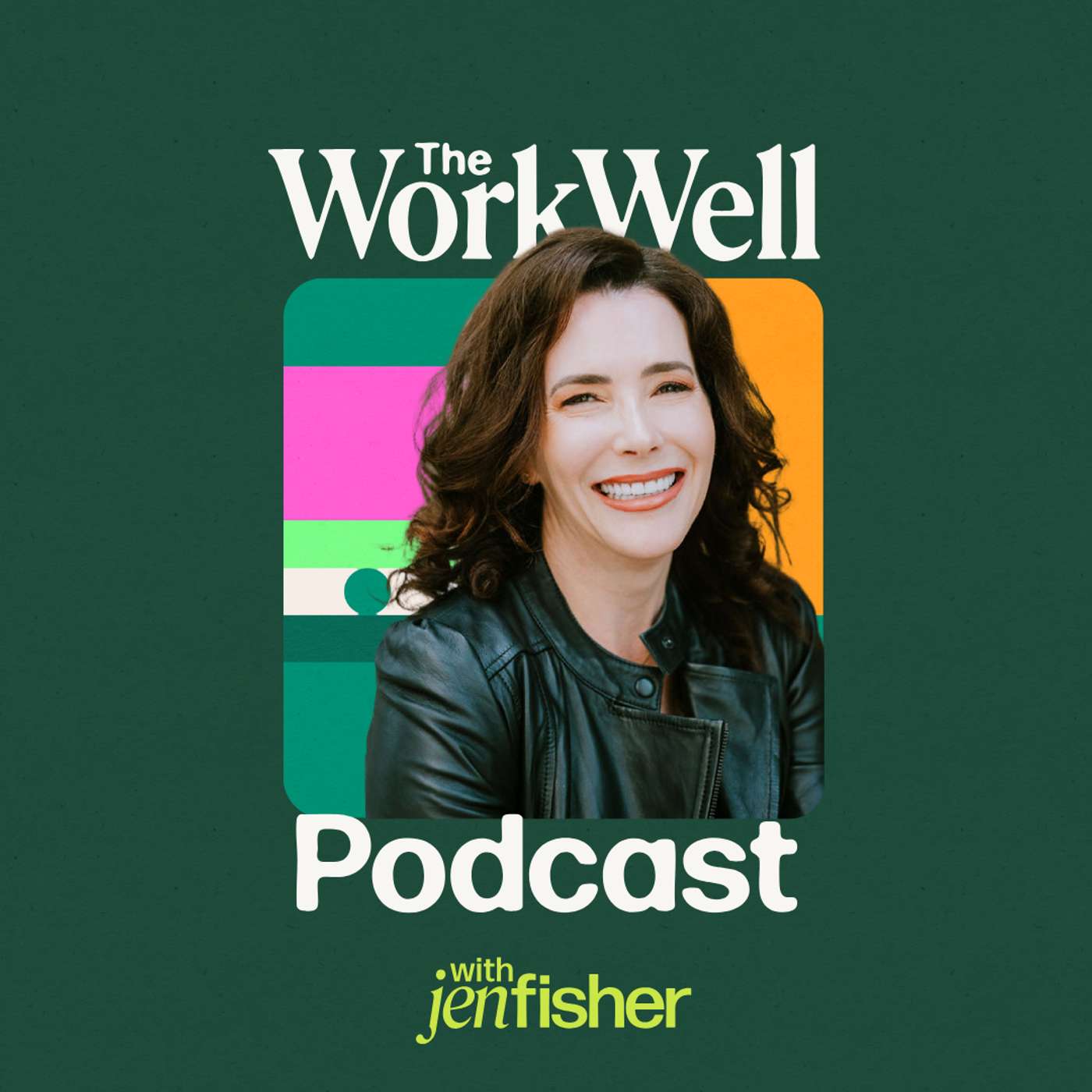
The Balanced Badass Podcast®
The Balanced Badass Podcast® is the show for high-achieving professionals who want to prevent burnout, master work-life balance, and stay badass without losing their sanity.
Each episode, we’re not just tackling your overflowing calendar and keeping your household on track; we’re getting into burnout prevention and recovery strategies so that you have time to breathe, laugh, and savor that much-needed glass of wine at the end of the day.
Think of this podcast as your regular dose of practical advice, a touch of humor, and a little tough love, like catching up with a friend who just gets it. Whether you’re navigating burnout, balancing meetings and meal prep, or carving out moments of self-care, this is the space where we figure it out together.
Disclaimer: My content is for educational purposes only and not a substitute for professional medical or mental health advice. For serious concerns, please consult a qualified provider.
The Balanced Badass Podcast®
Have You Been Set Up to Fail?
Feeling overwhelmed at work despite all your efforts? In this episode, we tackle whether your job is setting you up to fail with excessive expectations, lack of support, and unclear roles.
Discover the concept of the "everything job" and learn the 5 Cs driving burnout framework to identify unsustainable work conditions. Plus, get actionable advice on how to advocate for a more sustainable role using the 5 Ps of role design: Purpose, Priorities, Power, People, and Pace.
Whether you can't quit right away or need a paycheck, find out how to make your job work better for you. Tune in for a reality check that just might change how you see your job.
Check out the detailed show notes (https://tarakermiet.com/podcast/) and leave your thoughts or questions about today's topic.
Got something to say? Text me!
-----
I’m Tara Kermiet, a leadership coach, burnout strategist, and host of The Balanced Badass Podcast®. I help high-achievers and corporate leaders design careers that are successful and sustainable.
Here, you’ll find tactical tools, leadership lessons, and burnout education that just makes sense.
👉 Start by taking my free Burnout Drivers Mini Assessment
😍 Join my community on Instagram (@TaraKermiet) and/or TikTok (@TaraKermiet) so we can stay connected!
🎤 Got a question, a topic you want me to cover, or just want to share your thoughts? I'd love to hear from you! Send me a DM or email.
Stay balanced, stay badass, and make good choices!
Disclaimer: My content is for educational purposes only and not a substitute for professional medical or mental health advice. For serious concerns, please consult a qualified provider.
[00:00:00] Here's the question up for discussion today. Is your job setting you up to fail? You're working your ass off and still you are somehow falling short. Like no matter how many hours you put in, how many meetings you sit through, or how many fires you put out, there's always more, more expectations, more pressure, more shit that no one talks about, but you're just supposed to handle.
And then you're wondering, is it me? Am I not organized enough, not productive enough? Did I lose my edge? Let me stop you right there, because sometimes the issue isn't you at all. It's the job. More specifically, it's the fact that the job was never designed to be sustainable in the first place. Maybe the structure, the culture, and the expectations are all misaligned.
So let's talk about how to spot it, how it messes with your head and your confidence and what you can do about it. I wanna start with the rise of the everything job, [00:01:00] and here's what I mean by that. Historically, most jobs, at least in theory, had some kind of structure. You had a title, a scope, maybe a blurry line here or there.
But generally speaking, the boundaries were clear. Since then, those lines have kind of just dissolved. Now, one role can contain five jobs within it, and nobody even blinked when it happened. It's no longer that you are in charge of this one function.
Now you own strategy and operations. You lead the project and manage team. You facilitate hard conversations and take notes and send the recap and build the Asana board. Oh, and you are the DEI rep, the informal team therapist and the emotional shock absorber for everyone around you. All under one title.
And it's not always even in your job description. In fact, it usually isn't. What's happening is scope creep. It's the natural result of under-resourced teams, reactive [00:02:00] leadership and work culture that praises grit and ownership, but refuses to address systemic gaps. And oftentimes the everything job doesn't start out sounding terrible.
In fact, it often sounds exciting. It's pitched as a high impact opportunity. They'll say things like, you'll get to wear a lot of hats. This is a chance to really stretch yourself, or it's a visible role, which is great because you'll be working across teams and influencing key stakeholders, all the right things that you want to hear.
And you know what? Sometimes that can be true if there are guardrails, but if there's no clarity around what success looks like, if there's no limit to what might be asked of you next, if there's no support, no budget, no boundaries, and no one checking in on your capacity, that's not a high impact role.
It's a trap because you're not just doing your job anymore. You are doing five jobs, but you're only being paid for one, and you're being evaluated like you're failing because there's no way to [00:03:00] actually succeed at all of it. And that's the core problem with the everything job. It keeps growing and your bandwidth doesn't.
It keeps demanding more and no one's adjusting the expectations. And the longer you stay in it, the more it starts to feel like you are the problem instead of the structure around you. You are not just overwhelmed. You are being set up to fail. And listen, being set up to fail doesn't mean that you're being sabotaged as if someone's twirling their mustache in the boardroom trying to take you down.
More commonly, it looks like sky high, but totally vague expectations. You're supposed to drive results or increase impact or lead transformation, but no one has a clue as to what that actually looks like. Or maybe your resources are limited or completely non-existent. You're told to launch the project, fix the process, or build the thing, but you've got no team, no budget, and no time.
It could also be that priorities shift every other week. What was urgent last [00:04:00] Friday has now been forgotten, and what wasn't even on your radar is now suddenly your responsibility or you're being held accountable for outcomes that you don't even control. You're expected to deliver, but you're not given the authority to actually make key decisions.
To loop in the right people or to say no to anything that doesn't fit. And the major problem with all of this is that you are still evaluated, like you should be able to succeed. So if things don't go well, the finger points right back at you. Why didn't you raise a red flag earlier? You seem like you had it under control.
What happened? We trusted you to lead this, and now you've let us down. They're not asking if this was realistic in the first place, if the expectations were clear, or if you were given the right tools to succeed. Instead, you're praised for stepping up in one breath and then punished with more responsibility in the next.
And if you try to push back, you risk being seen as negative, ungrateful, or not a team player. [00:05:00] So the question becomes how do you know if that's what's really going on? How can you tell the difference between just a tough job and one that's fundamentally unsustainable? This is where the five Cs driving burnout framework comes in handy.
I use this with clients all the time to help them figure out what's at the root of their burnout. It helps you separate what's in your control from what's baked into the system. Plus, once you can name it, then you can do something with it, whether that's advocating, adjusting, or planning your exit. So let's walk through it.
The first C is conditions. This is the logistics of your job. What's the scope of your role? What are you expected to deliver and under what circumstances? Some of the red flags to look out for here are that you're doing the work of two or three people. You never get a break from the urgency or there's no space to think, plan or catch your breath.
You are constantly reacting and because everything is a priority, nothing really is. [00:06:00] It's about the fact that the workload is inherently unmanageable. Essentially, it's chronic overload with no relief in sight. Now, zoom out a little and look at the culture. What behaviors does your workplace reward? Not what they say in the onboarding deck, but what actually gets attention, praise, or promotion.
Your red flags here might be that skipping lunch is framed as commitment. Taking PTO is often frowned upon, and anytime you set a boundary, you somehow get punished. You can be in a job you love and still be in a culture that's eroding your wellbeing. And a lot of people miss this because culture is invisible until you challenge it.
But if overwork is the expectation, then burnout isn't an accident. It's a feature of the system. Now, let's go inward and examine your convictions. This one's a little sneaky because it's about what you believe. Not necessarily what's true. Look out for internal narratives. Like if I just worked harder, I can [00:07:00] fix this, or I should be able to handle it and even everyone else seems fine.
Maybe I'm just not built for this. This is how burnout gets internalized. You stop looking at the system and you start blaming yourself, but a lot of the stories you're telling yourself didn't start with you. They came from hustle, culture, childhood conditioning, or years in dysfunctional workplaces.
They're survival stories. They helped you succeed in the past, but when the system itself is broken, they just keep you stuck longer than you should be. Next one is choices. This one is all about power. You might be responsible for results, but have no real authority to make any decisions. This could look like being held accountable for outcomes, but not looped into decisions.
It could also look like you're raising legitimate concerns, but nothing happens. Or maybe you're being told to get creative with zero resources or support. [00:08:00] This isn't real autonomy. It's responsibility without agency, and it's one of the most toxic dynamics. It turns thoughtful, strategic people into reactive, exhausted ones.
And it leads to a tone of resentment and learn helplessness over time. Finally, we get to capacity, your energy, your focus, your mental bandwidth. We're looking at what's left in the tank. Are you forgetting simple things? Do you feel foggy, numb, or just emotionally flat? Are you struggling to do even simple tasks at work and at home?
This is executive function breakdown. Your brain's doing its best, but there's no fuel left to run the edge in. Imagine being handed a car with bald tires, a cracked windshield, no gas in the tank, and then being told, drive this cross country and don't stop. And by the way, we're measuring your performance based on how fast you get there.
That's what it feels like when your [00:09:00] capacity is gone, but the expectations don't adjust. You're being told to deliver peak results in a system that's giving you nothing to work with. So let's pause for a quick gut check. If you were nodding along to more than two of these Cs, there's a very real chance that the issue isn't your performance, it's the design of your role.
And once you see that clearly, the next question becomes, so now what? What if you can't quit tomorrow? What if you like parts of your job or you need a paycheck, which is very valid. But you also know that something's gotta give. The good news is that you don't need a full career pivot to start advocating for a more sustainable version of your role.
There are five questions that you can ask, either with your boss, with hr, or even just with yourself to figure out where the gaps are and what would need to change for this role to work better. [00:10:00] Let's call them the five Ps of role design, purpose, priorities, power people, and pace. So starting with purpose, every job should have a clear reason.
It exists a through line that ties your tasks to a meaningful business outcome. But when a role loses its purpose or never had one to begin with, it turns into a dumping ground. You start picking up random tasks and stretch projects and responsibilities that nobody else wants. And then before you know it, your job is a tangled mess of reactive work that doesn't connect back to anything meaningful.
So here's what I want you to do. I want you to ask yourself, what is the purpose of my role? Write a one sentence purpose statement, something like, this role exists to solve this problem by delivering this outcome. You're just clarifying what this role is supposed to contribute. Then you can take that to your manager and say something like, Hey, I've been thinking a lot [00:11:00] about how this role is evolving, and I wanna make sure that I'm clear on what the core purpose is.
Here's how I've been thinking about it. Does that line up with your expectations? If they agree, great, you've just established shared language, and you can use that to assess your current workload. But if they don't agree, that opens the door to talk about how things have drifted and what needs to shift to get things back on track.
Purpose gives you an anchor. Without it, you are just spinning around. And that brings us two priorities. Once you know the purpose of the role, the next question is what are the most important things you're supposed to be delivering on? Because like we said, if everything's important, nothing is. And most of the time people are overwhelmed, not because they're doing too much, but because they're doing too much without a clear sense of what actually matters.
So take a look at everything you're currently responsible for, projects, recurring tasks, team support, side [00:12:00] assignments, all of it, and start categorizing it. What's mission critical? What supports the work but isn't core? And then what's totally misaligned or could be delegated, automated or dropped. Once you've mapped that out, take it back to your manager and say, I'd like to make sure that I'm focusing my time on the highest impact outcomes.
Here's what I see as the top priorities based on the role's purpose, but I'd love to confirm that we're aligned so that way if I'm not, then I can get your input so I can adjust accordingly. This is how you start shifting from saying yes to everything, to being a strategic partner. It also creates a paper trail by the way, so if later someone questions why something didn't get done, you have some documentation around what the actual priorities were.
That's how you protect your time and your credibility. Now, let's talk about power. It is not reasonable to be held accountable for outcomes that you don't [00:13:00] have the authority or resources to influence. But this happens constantly. You're expected to drive results, but you can't make decisions. You can't access the right data, you can't approve spending or even influence timelines.
And then when something goes sideways, you're still the one on the hook.
So map out the key decisions that you're responsible for or expected to influence and list what you actually have access to. For example, if you're expected to own a project, but you need approvals from three layers above you, and you don't have a budget and the systems you need aren't accessible.
That's not ownership, that's actually a liability. Then you can take that map to your manager and say that, I want to be successful in this role. To do that. I need X decision rights, Y access, or Z authority. Otherwise, I'm managing outcomes. I can't control. Again, you're not whining. You're showing where the gaps are and what it would take to close them.
That's leadership [00:14:00] and hell That's advocating for success, not just for you, but for the organization. Next step is people. This is about support, collaboration, dependencies, because as we know, most jobs don't happen in a vacuum, especially the people focused, impact driven roles that so many of you are in.
And one of the biggest burnout traps I see is when your role depends on other people doing their jobs, but no one has ever made that explicit. You're waiting on someone from another team to review something. You're supporting multiple departments without clear agreements. You are managing up sideways and diagonally, and no one sees the toll that that's taking.
So here's the step for you. Make a visual map of the key people in teams that your role intersects with. Who do you collaborate with regularly? Who do you depend on for inputs, decisions, feedback, or approvals? And which parts of your job absolutely [00:15:00] cannot happen without them. Once you've got that map, you can have a conversation with your manager or with the teams themselves and say, I wanna make sure that we're all clear on responsibilities and timelines so that there's no confusion or delays.
Here's what I'm seeing, and I'd love to align expectations. That's how you start turning invisible labor into visible system. And if there's no support structure at all, you now have a clear case for why the role needs backup or maybe boundary setting. And finally, pace. This is the one everyone avoids because let's be honest, most of us were taught that we're supposed to be busy.
That pushing through is just part of the deal. That burnout is a personal issue, not a workload issue, but that's just not true. If your role literally cannot be done well within your standard work week, that's not your failure. That's a resourcing problem. Look at your current responsibilities and estimate the realistic time each one takes.[00:16:00]
Not the wishful thinking version, but the actual hours, including meetings, follow up thinking, time, coordination, everything that's involved. Add it up. Then I want you to compare that to the hours in your week. And if that number doesn't even come close to adding up, the math isn't math. That's your leverage point.
That's when you can say, right now, the scope of the role requires closer to 55 to 60 hours per week to do well. And I'd like to talk through how we can either reduce scope or add support to make this sustainable. You're being data-driven about what it takes to succeed in this role without sacrificing your health.
These five Ps, purpose, priorities, power, people, and pace are all about reclaiming agency. They give you some structure, language, leverage. They help you have adult conversations about what's realistic, what's aligned, and what needs to [00:17:00] shift. And even if leadership doesn't take you up on every suggestion, even if you don't get immediate relief, you'll still walk away with clarity.
Clarity about what you need. Clarity about what's off and not really working for you, and clarity about what you're no longer willing to carry quietly. And if the people around you can't meet you there, then you'll also be holding a blueprint for what to look for next time. Because the next role you step into that one won't be an everything job.
That one will be designed with intention because now you know what to look for. That's all I have for you today. As always, feel free to reach out to me in my dms with any specific questions you might have about your situation and if you found today's episode helpful, I'd love if you could share it with someone or leave a review.
Until next time, take care and make good choices, friend.
Podcasts we love
Check out these other fine podcasts recommended by us, not an algorithm.

Happier with Gretchen Rubin
Gretchen Rubin / The Onward Project
The Gratitude Attitude Podcast
thegratitudeattitudepodcast
Before Breakfast
iHeartPodcasts
A Bit of Optimism
Simon Sinek
Oprah's Super Soul
Oprah
Stuff You Should Know
iHeartPodcasts
Unlocking Us with Brené Brown
Vox Media Podcast Network
We Can Do Hard Things
Treat Media and Glennon Doyle
Take Out Therapy: End Overthinking & Overwhelm for Empathic High Achievers
Rebecca Hunter, MSW
FRIED. The Burnout Podcast
Cait Donovan
